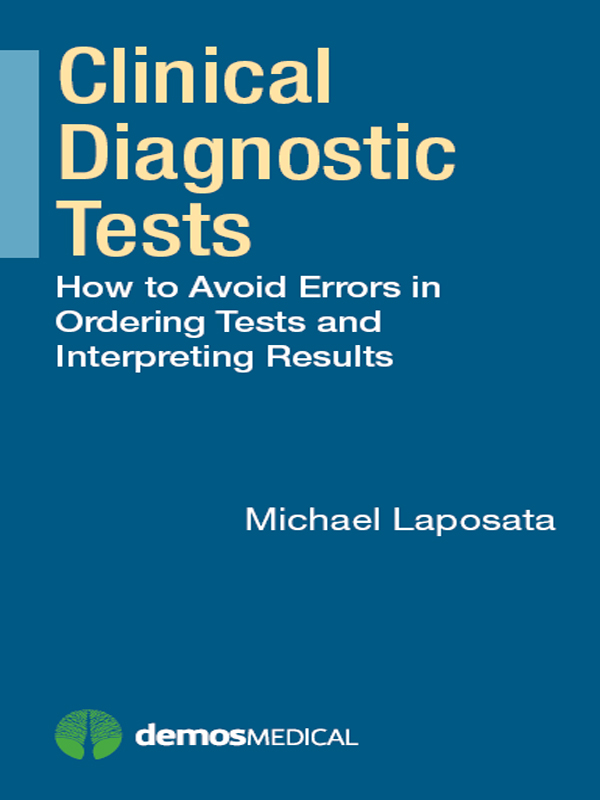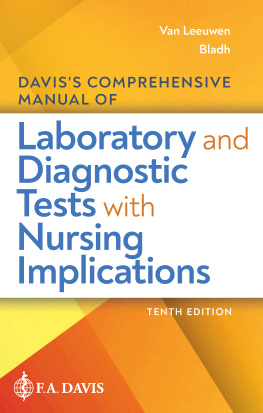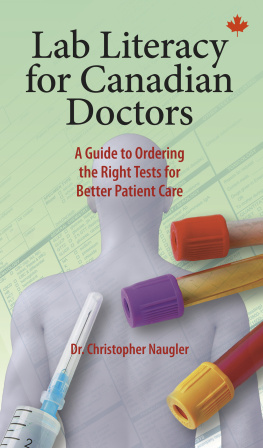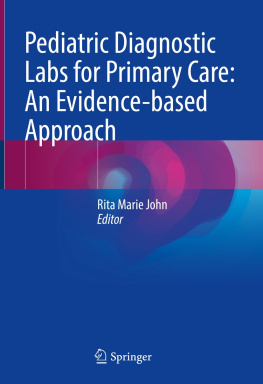Michael Laposata - Clinical Diagnostic Tests: How to Avoid Errors in Ordering Tests and Interpreting Results
Here you can read online Michael Laposata - Clinical Diagnostic Tests: How to Avoid Errors in Ordering Tests and Interpreting Results full text of the book (entire story) in english for free. Download pdf and epub, get meaning, cover and reviews about this ebook. year: 2016, publisher: Demos Medical Publishing, genre: Science. Description of the work, (preface) as well as reviews are available. Best literature library LitArk.com created for fans of good reading and offers a wide selection of genres:
Romance novel
Science fiction
Adventure
Detective
Science
History
Home and family
Prose
Art
Politics
Computer
Non-fiction
Religion
Business
Children
Humor
Choose a favorite category and find really read worthwhile books. Enjoy immersion in the world of imagination, feel the emotions of the characters or learn something new for yourself, make an fascinating discovery.
- Book:Clinical Diagnostic Tests: How to Avoid Errors in Ordering Tests and Interpreting Results
- Author:
- Publisher:Demos Medical Publishing
- Genre:
- Year:2016
- Rating:5 / 5
- Favourites:Add to favourites
- Your mark:
- 100
- 1
- 2
- 3
- 4
- 5
Clinical Diagnostic Tests: How to Avoid Errors in Ordering Tests and Interpreting Results: summary, description and annotation
We offer to read an annotation, description, summary or preface (depends on what the author of the book "Clinical Diagnostic Tests: How to Avoid Errors in Ordering Tests and Interpreting Results" wrote himself). If you haven't found the necessary information about the book — write in the comments, we will try to find it.
Michael Laposata: author's other books
Who wrote Clinical Diagnostic Tests: How to Avoid Errors in Ordering Tests and Interpreting Results? Find out the surname, the name of the author of the book and a list of all author's works by series.
Clinical Diagnostic Tests: How to Avoid Errors in Ordering Tests and Interpreting Results — read online for free the complete book (whole text) full work
Below is the text of the book, divided by pages. System saving the place of the last page read, allows you to conveniently read the book "Clinical Diagnostic Tests: How to Avoid Errors in Ordering Tests and Interpreting Results" online for free, without having to search again every time where you left off. Put a bookmark, and you can go to the page where you finished reading at any time.
Font size:
Interval:
Bookmark:

How to Avoid Errors in Ordering Tests and Interpreting Results
Edited by
Michael Laposata, MD, PhD
Professor and Chair
Department of Pathology
University of Texas Medical BranchGalveston
Galveston, Texas

Visit our website at www.demosmedical.com
ISBN: 9781620700839
e-book ISBN: 9781617052620
Acquisitions Editor: Rich Winters
Compositor: diacriTech
2016 Demos Medical Publishing, LLC. All rights reserved. This book is protected by copyright. No part of it may be reproduced, stored in a retrieval system, or transmitted in any form or by any means, electronic, mechanical, photocopying, recording, or otherwise, without the prior written permission of the publisher.
Medicine is an ever-changing science. Research and clinical experience are continually expanding our knowledge, in particular our understanding of proper treatment and drug therapy. The authors, editors, and publisher have made every effort to ensure that all information in this book is in accordance with the state of knowledge at the time of production of the book. Nevertheless, the authors, editors, and publisher are not responsible for errors or omissions or for any consequences from application of the information in this book and make no warranty, expressed or implied, with respect to the contents of the publication. Every reader should examine carefully the package inserts accompanying each drug and should carefully check whether the dosage schedules mentioned therein or the contraindications stated by the manufacturer differ from the statements made in this book. Such examination is particularly important with drugs that are either rarely used or have been newly released on the market.
Library of Congress Cataloging-in-Publication Data
Clinical diagnostic tests : how to avoid errors in ordering tests and interpreting results / editor, Michael Laposata.
p. ; cm.
Includes bibliographical references and index.
ISBN 978-1-62070-083-9ISBN 978-1-61705-262-0 (ebook)
I. Laposata, Michael, editor.
[DNLM: 1. Clinical Laboratory Techniquesmethods. 2. Diagnostic Tests, Routinemethods. 3. Diagnostic Errorsprevention & control. WB 200]
RC71.2
616.07'5dc23
2015016835
Special discounts on bulk quantities of Demos Medical Publishing books are available to corporations, professional associations, pharmaceutical companies, health care organizations, and other qualifying groups. For details, please contact:
Special Sales Department
Demos Medical Publishing, LLC
11 West 42nd Street, 15th Floor
New York, NY 10036
Phone: 800-532-8663 or 212-683-0072
Fax: 212-941-7842
E-mail:
Printed in the United States of America by Gasch.
14 15 16 17 / 5 4 3 2 1
Quentin G. Eichbaum, Garrett S. Booth, and Pampee P. Young
Michael Laposata
Adam C. Seegmiller and Mary Ann Thompson Arildsen
James H. Nichols and Carol A. Rauch
Charles W. Stratton
Candis A. Kinkus
Mary Ann Thompson Arildsen, MD, PhD
Department of Pathology, Microbiology and Immunology
Vanderbilt University School of Medicine
Nashville, Tennessee
Garrett S. Booth, MD, MS
Department of Pathology, Microbiology and Immunology
Vanderbilt University School of Medicine
Nashville, Tennessee
Quentin G. Eichbaum, MD, PhD, MPH, MFA, MMHC, FCAP
Department of Pathology, Microbiology and Immunology
Vanderbilt University School of Medicine
Nashville, Tennessee
Candis A. Kinkus, MBA
Diagnostic Laboratories
Vanderbilt University Medical Center
Nashville, Tennessee
Michael Laposata, MD, PhD
Department of Pathology
University of Texas Medical BranchGalveston
Galveston, Texas
James H. Nichols, PhD, DABCC, FACB
Department of Pathology, Microbiology and Immunology
Vanderbilt University School of Medicine
Nashville, Tennessee
Carol A. Rauch, MD, PhD, FCAP
Department of Pathology, Microbiology and Immunology
Vanderbilt University School of Medicine
Nashville, Tennessee
Adam C. Seegmiller, MD, PhD
Department of Pathology, Microbiology and Immunology
Vanderbilt University School of Medicine
Nashville, Tennessee
Charles W. Stratton, MD
Department of Pathology, Microbiology and Immunology
Vanderbilt University School of Medicine
Nashville, Tennessee
Pampee P. Young, MD, PhD
Department of Pathology, Microbiology and Immunology; and
Department of Medicine
Vanderbilt University School of Medicine
Nashville, Tennessee
The Institute of Medicine in the United States has recently organized a committee, of which I am a member, on diagnostic error in health care. It has become clear that major contributors to diagnostic mistakes include the incorrect selection of laboratory tests and the misinterpretation of laboratory test results. As the clinical laboratory test menu has greatly expanded in the past decade in size, complexity, and cost, the challenge of ordering the right tests, and only the right tests, and correctly interpreting complex test results, has become a significant challenge for most health care providers for a larger and larger percentage of their patients.
The idea to produce books describing medical errors related to inappropriate selection of laboratory tests and misinterpretation of laboratory test results first emerged in a discussion in a restaurant in Chicago. The first challenge was to determine whose medical errors would be reported. Would this be a compilation of medical errors reported in the literature, personally observed medical errors in the experience of an author, or admissions of unpublished mistakes by medical colleagues? Ultimately, it was decided to invite established experts in the different areas of laboratory medicine to become authors who could bring forward errors that they had read about, personally encountered, or learned from discussions with clinical and laboratory colleagues. The goal for each author was to identify and describe the most common mistakes in his or her specialty area of laboratory medicine, and then use those mistakes to create a set of standards of care that would lead to a reduction in the frequency of those errors. Six separate books were produced in the series, and they describe errors in laboratory testing for coagulation, transfusion medicine, clinical chemistry, clinical microbiology, hematology and immunology, and the often overlooked area of laboratory management. The organization of each book is similar. A major group of diagnostic errors associated with the clinical laboratory (such as those in which an abscess is mistakenly concluded to be a malignancy because of findings in the microbiology laboratory) is introduced with a brief background on that group of medical errors, followed by an actual case to illustrate this error, then a short statement that describes the clinical pitfall, and finally a list of standards of care related to, in this example, appropriate testing to minimize the number of cases mistakenly identified as abscesses that are, in fact, malignancies. After production of the last of the six books, it was recognized that removal of the case examples would allow all six books to be combined into the one clinically valuable book which follows this preface.
Font size:
Interval:
Bookmark:
Similar books «Clinical Diagnostic Tests: How to Avoid Errors in Ordering Tests and Interpreting Results»
Look at similar books to Clinical Diagnostic Tests: How to Avoid Errors in Ordering Tests and Interpreting Results. We have selected literature similar in name and meaning in the hope of providing readers with more options to find new, interesting, not yet read works.
Discussion, reviews of the book Clinical Diagnostic Tests: How to Avoid Errors in Ordering Tests and Interpreting Results and just readers' own opinions. Leave your comments, write what you think about the work, its meaning or the main characters. Specify what exactly you liked and what you didn't like, and why you think so.








